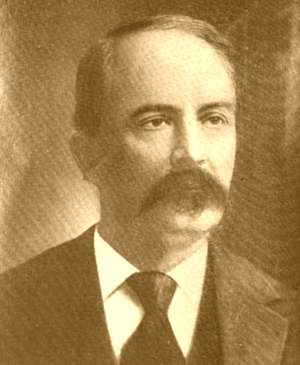Samuel Houston Mayes facts for kids
Samuel Houston Mayes (born May 11, 1845 – died December 12, 1927) was an important leader of the Cherokee Nation. He was elected as their Principal Chief, like a president, and served from 1895 to 1899. This was a challenging time for Native American tribes.
Samuel Mayes had both Scottish/English and Cherokee family roots. His mother's family was part of the Deer clan, which was important in Cherokee society. His father's family was connected to leaders like Elias Boudinot and Major Ridge. Samuel's older brother, Joel B. Mayes, also served as Chief of the Cherokee Nation before him.
Samuel Mayes was born in Indian Territory, which is now Oklahoma. He went to a Cherokee school and later fought in the American Civil War for the Confederacy. After the war, he became a successful cattle rancher. He entered politics when the United States government was trying to change how Native American tribes lived. They were taking away tribal lands and giving small plots to individual families. This was an effort to make Native Americans live more like European-Americans, under laws like the Dawes and Curtis Acts.
Contents
Early Life and Family
Samuel Houston Mayes was born on May 11, 1845. His birthplace was near what is now Stilwell, Oklahoma. His parents were Samuel and Nancy (Adair) Mayes. His mother, Nancy, had Cherokee and Scottish roots. Her grandmother was a full-blood Cherokee woman from the Deer clan.
The Cherokee people followed a matrilineal system. This meant children belonged to their mother's clan and got their social standing from her. Samuel Mayes (his father) joined the Adair family and the Cherokee community when he married Nancy. Samuel Houston Mayes was named after his father's friend, Sam Houston, a famous person from Tennessee. The Mayes family moved to Indian Territory early on, along with other important Cherokee families.
Samuel had an older brother named Joel B. Mayes. Joel became the Chief of the Cherokee Nation in 1887 and 1891. Another older brother, Francis, sadly died while returning from California. Samuel and his younger brothers went to the Cherokee Male Seminary in Tahlequah, Indian Territory. This was an important school for young Cherokee men.
War and Business
When he was 16, Samuel Mayes joined the Confederate Army during the American Civil War. He served in the 2nd Cherokee Regiment throughout the war. After the war ended, he worked in Texas for a while.
He then returned to Indian Territory and started a business raising cattle. Both he and his brother were involved in the cattle business. This industry was growing, with ranchers using Texas longhorn cattle. They would drive the cattle north to railroad stations to sell them.
Marriage and Children
Samuel Mayes married Martha Elizabeth Vann on November 9, 1871. She also came from a well-known Cherokee family and had mixed heritage. They had three children who grew up: William Lucullus, Joseph Francis, and M. Carrie Mayes. Joseph Francis later became a doctor. M. Carrie Mayes married Clarence Samuels.
After Martha's death, Samuel Mayes married Minnie Harrison (who was a widow) on February 18, 1913. Minnie survived him.
Political Journey
Samuel Mayes began his political career in 1880. He was first elected as the sheriff of the Coo-wee-scoo-wee District. From 1885 to 1891, he served as a senator for the same district. He belonged to the Downing political party, just like his brother. In 1895, he was elected as the Principal Chief of the Cherokee Nation.
During his time as Chief, the United States government was making big changes. In 1893, the U.S. Congress created the Dawes Commission. This group was tasked with registering members of Native American tribes. They also aimed to divide up tribal lands, which had been owned by the whole community. The goal was to encourage Native Americans to live like American farmers.
In 1896, during Chief Mayes' term, the Dawes Commission took over the Cherokee Nation's power to decide who was a citizen. The U.S. government wanted to break up tribal governments. They planned to combine the Oklahoma and Indian territories into a new state. The Curtis Act in 1898 further pushed these changes. It ended tribal courts and ordered that tribal lands be divided among individual members. The U.S. government, through the Bureau of Indian Affairs (BIA), even started appointing chiefs for tribes.
The Cherokee leaders tried to resist these changes. However, they were forced into talks with the U.S. government. Eventually, the Five Civilized Tribes, including the Cherokee, had to agree to the land division process.
On January 7, 1899, Chief Mayes appointed seven Cherokee delegates to work with the Dawes Commission. These delegates agreed to let the Cherokee people vote on dividing their lands and ending their government. On January 31, 1899, the Cherokee people voted to approve this agreement. However, the U.S. Congress never officially approved it. This delay helped the Cherokee get a better agreement in 1902.
Even with a better agreement, dividing the communal lands changed an important Cherokee tradition. Before, no member of the tribe would be homeless, and everyone could help each other. The Cherokee lands were divided into plots of about 110 acres for each family. Any land left over was called "surplus" by the U.S. government and sold to non-Native settlers.
Later Life and Recognition
Samuel Mayes passed away on his farm on December 12, 1927. He died in Pryor Creek, Oklahoma.
Mayes County, Oklahoma, where he lived for many years, was named in his honor. This shows how important he was to the area.


